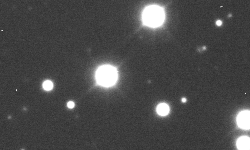Iocaste (moon)
Iocaste, also known as Jupiter XXIV, is a retrograde irregular satellite of Jupiter. It was discovered by a team of astronomers from the University of Hawaii led by Scott S. Sheppard in 2000, and given the temporary designation S/2000 J 3.[6][1]
 Iocaste imaged by the Canada-France-Hawaii Telescope in December 2001 | |
| Discovery [1] | |
|---|---|
| Discovered by | Scott S. Sheppard David C. Jewitt Yanga R. Fernandez Eugene A. Magnier |
| Discovery site | Mauna Kea Observatory |
| Discovery date | 23 November 2000 |
| Designations | |
Designation | Jupiter XXIV |
| Pronunciation | /aɪoʊˈkæstiː/ |
Named after | Ιοκάστη Iokástē or Jocasta |
| S/2000 J 3 | |
| Adjectives | Iocastean /ˌaɪoʊkæˈstiːən/[2] |
| Orbital characteristics [3] | |
| Epoch 17 December 2020 (JD 2459200.5) | |
| Observation arc | 17.39 yr (6,350 days) |
| 0.1432617 AU (21,431,650 km) | |
| Eccentricity | 0.3294908 |
| –640.97 d | |
| 289.50565° | |
| 0° 33m 41.927s / day | |
| Inclination | 149.42446° (to ecliptic) |
| 343.53045° | |
| 110.27239° | |
| Satellite of | Jupiter |
| Group | Ananke group |
| Physical characteristics[4] | |
Mean diameter | 5 km |
| Albedo | 0.04 (assumed) |
| 21.8[5] | |
| 15.5[3] | |
Iocaste orbits Jupiter at an average distance of 20.723 million kilometers in 640.97 days, at an inclination of 147° to the ecliptic (146° to Jupiter's equator) with an eccentricity of 0.2874.
It was named in October 2002 after Jocasta,[7] the mother/wife of Oedipus in Greek mythology.
Iocaste belongs to the Ananke group, believed to be the remnants of a break-up of a captured heliocentric asteroid.[8][9]
The satellite is about 5 kilometres in diameter[10] and appears grey (colour indices B−V=0.63, R−V=0.36), similar to C-type asteroids.[11]
See also
References
- Brian G. Marsden (5 January 2001). "S/2000 J 2, S/2000 J 3, S/2000 J 4, S/2000 J 5, S/2000 J 6". International Astronomical Union Minor Planet Center.
- Kin'ya Tsuruta (1996) Shiga Naoya's A Dark Night's Passing, p. 92
- "M.P.C. 127087" (PDF). Minor Planet Circular. Minor Planet Center. 17 November 2020.
- "Planetary Satellite Physical Parameters". Jet Propulsion Laboratory. 19 February 2015. Retrieved 26 November 2020.
- Sheppard, Scott. "Scott S. Sheppard - Jupiter Moons". Department of Terrestrial Magnetism. Carnegie Institution for Science. Retrieved 26 November 2020.
- Daniel W. E. Green (5 January 2001). "Satellites of Jupiter". International Astronomical Union Central Bureau for Astronomical Telegrams.
- Daniel W. E. Green (22 October 2002). "Comet P/2002 T5 (Linear)". International Astronomical Union Central Bureau for Astronomical Telegrams.
- Sheppard, S. S.; Jewitt, D. C.; "An Abundant Population of Small Irregular Satellites Around Jupiter" Archived August 13, 2006, at the Wayback Machine, Nature, Vol. 423 (May 2003), pp. 261–263
- Nesvorný, D.; Alvarellos, J. L. A.; Dones, L.; and Levison, H. F.; "Orbital and Collisional Evolution of the Irregular Satellites", The Astronomical Journal, Vol. 126 (2003), pp. 398–429
- Sheppard, S. S.; Jewitt, D. C.; Porco, C. C.; "Jupiter's Outer Satellites and Trojans" Archived June 14, 2007, at the Wayback Machine, in Jupiter: The Planet, Satellites and Magnetosphere, edited by Fran Bagenal, Timothy E. Dowling, and William B. McKinnon, Cambridge Planetary Science, Vol. 1, Cambridge, UK: Cambridge University Press, ISBN 0-521-81808-7, 2004, pp. 263–280
- Grav, T.; Holman, M. J.; Gladman, B. J.; and Aksnes, K.; "Photometric survey of the irregular satellites", Icarus, Vol. 166 (2003), pp. 33–45
Further reading
- Ephemeris IAU-MPC NSES
- Mean orbital parameters NASA JPL